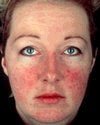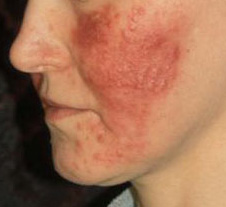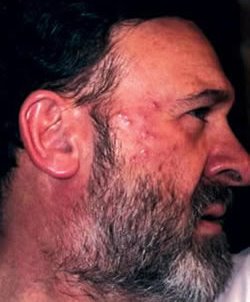
We’d like to show you some rosacea pictures to help you recognize the condition in yourself or in others. These photos of rosacea will show you people with various symptoms of rosacea and people with both mild and severe cases. Remember, though, that other conditions can cause similar symptoms. See your doctor if you have questions about your diagnosis or condition.

Rosacea Pictures Showing Red, Inflamed Skin
These photos show you how various people with rosacea look, with a red face and skin that looks irritated or inflamed. You can see how the redness is mild to moderate in some people and severe and rather painful-looking in others. You can also see how the blood vessels in the face appear enlarged and unusually noticeable in some of these pictures. While most of these pictures focus on the face, people can have these symptoms on their necks, backs, and chests, as well. What you can’t see from looking at pictures is that people with rosacea that looks like this often experience itchy skin and dry, irritated eyes, in addition to red and inflamed skin.
Photos of Rosacea Acne

Some people with rosacea develop small, pus-filled bumps that resemble acne. In fact, rosacea that appears like this is often misdiagnosed as acne at first. Technically, it is known as papulopustular rosacea. That’s what you see in these rosacea pictures. This type of rosacea can appear on the neck, back, and chest, as well as on the face. People with papulopustular rosacea often have skin that feels warm or hot and sore or tender to the touch, as well.
Pictures of Phymatous Rosacea

People with phymatous rosacea develop abnormal thickening of the skin tissue on the face, particularly around the nose. According to the Mayo Clinic, this is more common in men with rosacea than in women, for some reason, although women can experience it, too. Often, this gives the nose a bulbous appearance, called rhinophyma, as seen in the picture.
What if You Recognize Yourself in These Rosacea Pictures?
There are treatments available that reduce or even eliminate the symptoms of rosacea. It’s important to be certain of your diagnosis, though, because other conditions may resemble rosacea but may not respond to the same treatments. Diagnosing yourself based on some photos of rosacea is not always accurate, so we suggest you see your doctor or visit a dermatologist (a doctor specializing in skin disorders) to confirm a diagnosis of rosacea.

Getting treatment for rosacea is important because not only does it relieve discomfort and improve your appearance, but it can also help prevent the condition from getting worse. Untreated, symptoms often worsen over time and may also spread from the face to other areas of the body, such as the neck, back, and chest.
Medical treatments for rosacea include anti-inflammatory drugs, antibiotics, acne medications like isotretinoin (Amnesteem, Claravis, Sotret), laser therapy, and dermabrasion. Some people prefer to use home remedies or natural remedies for rosacea, like tea tree oil, licorice root extract, emu oil, or feverfew. Natural treatments are less likely to cause unwanted side effects but they aren’t always very effective. Talk with your doctor about the best treatment for you and let your doctor know if you are concerned about possible side effects of medical treatments for rosacea and if you prefer to try a natural treatment for your condition.
Natural Treatment For Rosacea
If you’re interested in trying natural treatment for rosacea, we suggest the Skin Support System from Zenmed. Made from all-natural botanical ingredients like tea tree oil, cucumber, green tea extract, and jojoba oil, these products reduce redness and inflammation like you see in these photos. They also treat the acne-like symptoms you see in the pictures here, returning your skin to a normal, healthy condition. To learn more, just follow this link to the Zenmed Website.
Mayo Clinic: Rosacea Symptoms
